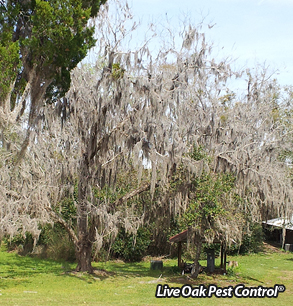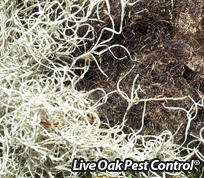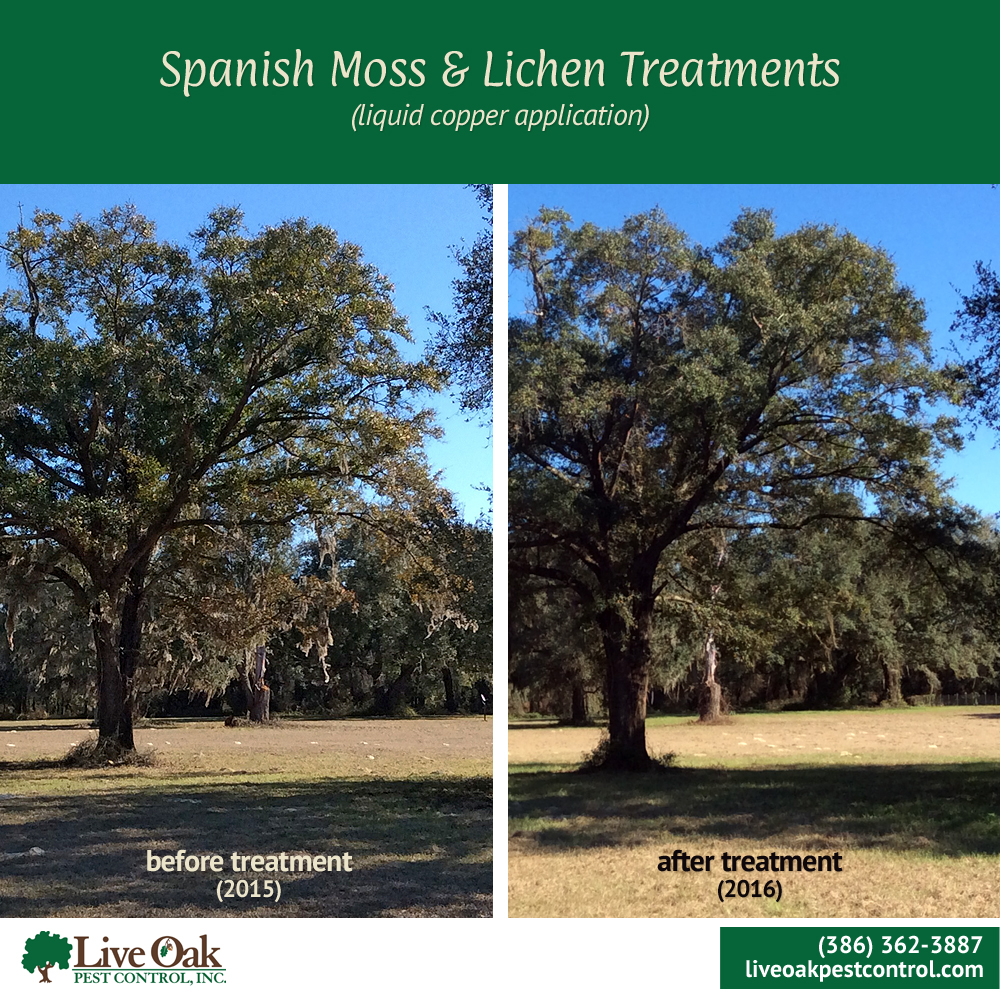Spanish MossJanuary Pest of the Month.

What is Spanish Moss & what causes it?
To the native Floridian, Spanish moss also, called Florida moss, long moss or graybeard, is part of the Florida scenery. To many newcomers and visitors, however, this strange air plant is a subject of much speculation and wonder. Contrary to what most people believe, Spanish moss does not injure the tree by obtaining any nourishment from it. Being an air plant, it only uses the tree for support.
Live oaks especially seem well-suited for harboring this plant and most Florida live oaks of any size have some Spanish moss. But many other tree species also harbor this plant. Healthy moss is often seen growing on dead trees, fences and power lines as well.
Spanish moss occurs in all Florida counties and is very common to very rare depending on the location. It loves the humidity. It is also widely distributed from southern Virginia to eastern Texas along the coastal strip of the southeastern United States. Ball moss (Tillandisia recurvata) is sometimes confused with Spanish moss but is a small tufted, soft, greenish-gray plant. Often the two species are found growing in the same tree.
Jump to section: Appearance | Damage | Symptoms | Habitat | Treatment | More Information
General Appearance
 The leaves are grayish-green, up to 2 inches long and linear. The plant has numerous branches and is covered with silvery-gray scales. It's generally seen draped and hanging over the branches of trees. Flowers of Spanish moss are tiny blooms of pale greenish-blue that may give a light fragrance at night. It produces seeds after flowers which are carried by wind and birds to form new clusters of Spanish moss. It is most commonly found on oak and cypress trees but can be found on other tree species as well.
The leaves are grayish-green, up to 2 inches long and linear. The plant has numerous branches and is covered with silvery-gray scales. It's generally seen draped and hanging over the branches of trees. Flowers of Spanish moss are tiny blooms of pale greenish-blue that may give a light fragrance at night. It produces seeds after flowers which are carried by wind and birds to form new clusters of Spanish moss. It is most commonly found on oak and cypress trees but can be found on other tree species as well.
The picture to the left shows you what live Spanish Moss looks like and what dead Spanish Moss looks like. The live spanish moss is light gray in color and the dead moss appears dark brown and a lot stringier. Click the image to see a bigger view.
- It's covered in scales to trap water and nutrients needed to survive and prosper.
- Spanish moss produces flowers which then form seeds and are very small and usually dispersed by the wind.
- It is not a fungus, rather an air plant.
- Spanish moss is often found by swamps, rivers and other large water sources.
- Insects such as Red Bugs and small reptiles are attracted to the tangled strands of Spanish moss for living quarters and hiding.
- Spanish moss produces its own food and does not receive food from its host.
- Spanish moss is an epiphytic plant meaning it grows on another plant but makes its own food.
Also listen to recorded radio interviews with Roy Crain Jr. discussing this month's pest.
Damage to Trees
 Although Spanish moss does not obtain nourishment from a tree, it can sometimes cause tree damage. This occurs when weak tree limbs become heavily overloaded with moss and break off. The foliage of small branches may sometimes be smothered, too. An abundance of Spanish moss on a tree can prevent the tree from performing its natural photosynthesis due to shading the tree so heavily with moss. Spanish moss causes the most trouble in economic crop trees such as pecans and citrus by the lack of fruit and nut production when the moss grows too thick on the tree. Its ability to hold moisture increases the tree's exposure to ice and frost damage although it also gives itself a chance to survive and remain dormant during dry spells until moisture returns. In shade trees, however, people usually remove it because they do not like the way it looks, not because of any damage it might do.
Although Spanish moss does not obtain nourishment from a tree, it can sometimes cause tree damage. This occurs when weak tree limbs become heavily overloaded with moss and break off. The foliage of small branches may sometimes be smothered, too. An abundance of Spanish moss on a tree can prevent the tree from performing its natural photosynthesis due to shading the tree so heavily with moss. Spanish moss causes the most trouble in economic crop trees such as pecans and citrus by the lack of fruit and nut production when the moss grows too thick on the tree. Its ability to hold moisture increases the tree's exposure to ice and frost damage although it also gives itself a chance to survive and remain dormant during dry spells until moisture returns. In shade trees, however, people usually remove it because they do not like the way it looks, not because of any damage it might do.
Life History
Spanish moss is a flowering plant belonging to the pineapple family. Most stands sprout from a seed that is equipped with a feathery parachute which floats through the air until it lodges on a tree trunk or other suitable seed bed. Several strands may grow simultaneously from one seed. Strands and minute pieces of moss carried by wind or birds to suitable locations also grow into new festoons. Hurricanes are said to spread moss. Being an epiphyte (air plant), Spanish moss gets it nourishment from rain water and air. Probably dust in the air also supplies some of its nourishment. Moss has the ability to absorb quantities of moisture from the air. Studies have shown that moss contains the same proportions of certain chemicals as the surrounding air.
Treatment
 Sometimes people living in Florida want to control Spanish moss because a tree may be covered in it or have thick patches that will not allow new tree growth. When this happens you can count on Live Oak Pest Control to keep down the Spanish moss by using a unique and chemical. Generally, we limit Spanish moss treatment on trees the size of a large dogwood (about 30 - 40 feet).
Sometimes people living in Florida want to control Spanish moss because a tree may be covered in it or have thick patches that will not allow new tree growth. When this happens you can count on Live Oak Pest Control to keep down the Spanish moss by using a unique and chemical. Generally, we limit Spanish moss treatment on trees the size of a large dogwood (about 30 - 40 feet).
Listen to recorded radio interviews with Roy Crain Jr. discussing this month's pest.
Poems
There are many different stories and interpretations about Spanish Moss and how it evolved. Most literature surrounding Spanish Moss are romantic and involve couples of one kind or another. Below are a couple poems about Spanish Moss.
“There's an old, old legend, that's whispered by Southern folks,
About the lacy Spanish moss that garlands the great oaks-
A lovely princess and her love, upon their wedding day,
Were struck down by a savage foe amidst a bitter fray;
United in death they were buried, so the legends go-
‘Neath an oak's strong, friendly arms, protected from their foe;
There, as was the custom, they cut the bride's long hair with love,
And hung its shining blackness on the spreading oak above;
Untouched, undisturbed, it hung there, for all the world to see
And with the years the locks turned grey, and spread from tree to tree.”
Courtesy of: www.greatstoryteller.com
Another poem is the plight of poor Don Gorez Goz:
“Rough, old meanie that he was,
From Spain came don Gorez Goz.
As he cast a wary eye about
A pretty lass espied this lout,
He bought her - this Indian maid-
For a cake of soap, a yard of braid,
The grieving beauty fled with cause
For tarnished braid indeed it was,
Gorez pursued both hard and fast
Until she climbed a tree at last,
As Gorez followed her he leered.
How those branches caught his beard!
The beard remains, but Gorez has gone
And still the tale goes on and on,
What an ominous warning it should be,
To see Spanish Moss hang from a tree,
A cake of soap and a yard of braid
May be enough to win some maid.
Look, though, swain, and make thou sure
The braid is clean, untarnished - pure!”
Courtesy of: www.ashleighaustin.com
In the southeastern United States, the following tale is told:
As the story goes: There was once a traveler who came with his Spanish fiancée in the 1700s to start a plantation near the city of Charleston, South Carolina. She was a beautiful bride-to-be with long flowing raven hair. As the couple was walking over the plantation sight [sic] near the forest, and making plans for their future, they were suddenly attacked by a band of Cherokee who were not happy to share the land of their forefathers with strangers. As a final warning to stay away from the Cherokee nation, they cut off the long dark hair of the bride-to-be and threw it up in an old live oak tree. As the people came back day after day and week after week, they began to notice the hair had shriveled and turned grey and had begun spreading from tree to tree. Over the years the moss spread from South Carolina to Georgia and Florida. To this day, if one stands under a live oak tree, one will see the moss jump from tree to tree and defend itself with a large army of beetles.
Courtesy of: Wikipedia
More Information
- Identifying Characteristics of Spanish Moss : University of Florida
- Plant Guide (Spanish Moss) : USDA National Resources Conservation Service (PDF; you must have Adobe Acrobat or Reader installed)
- Spanish Moss Plant Guide : Garden Guides.com
- The Truth About Spanish Moss : Sarasota County Forestry
- Spanish Moss : America's Wetland Resources
